Mixed Layer Heat Variations in the South China Sea Observed by Argo Float and Reanalysis Data during 2012–2015
Abstract
1. Introduction
2. Materials and Methods
2.1. Argo Profiles
2.2. Mixed Layer Heat Budget
3. Results
3.1. Residual in the Mixed Layer Heat Budget Equation
3.2. Annual Mean and Seasonal Variability
4. Discussion
4.1. Summer And Winter Net Heat Flux
4.2. Summer and Winter Horizontal Advection
4.3. Possible Impacts on Vertical Entrainment
4.4. Possible Causes of the Residual
5. Conclusions
Author Contributions
Funding
Conflicts of Interest
References
- Qu, T.; Du, Y.; Sasaki, H. South China Sea throughflow: A heat and freshwater conveyor. Geophys. Res. Lett. 2006, 33. [Google Scholar] [CrossRef]
- Xiao, F.A.; Wang, D.X.; Zeng, L.L.; Liu, Q.Y.; Zhou, W. Contrasting changes in the sea surface temperature and upper ocean heat content in the South China Sea during recent decades. Clim. Dyn. 2019, 53, 1597–1612. [Google Scholar] [CrossRef]
- Zeng, L.; Schmitt, R.W.; Li, L.; Wang, Q.; Wang, D.J.C.D. Forecast of summer precipitation in the Yangtze River Valley based on South China Sea springtime sea surface salinity. Clim. Dyn. 2019, 1–15. [Google Scholar] [CrossRef]
- Zeng, L.L.; Liu, W.T.; Xue, H.J.; Xiu, P.; Wang, D.X. Freshening in the South China Sea during 2012 revealed by Aquarius and in situ data. J. Geophys. Res. Ocean. 2014, 119, 8296–8314. [Google Scholar] [CrossRef]
- Zeng, L.L.; Wang, D.X.; Xiu, P.; Shu, Y.Q.; Wang, Q.; Chen, J. Decadal variation and trends in subsurface salinity from 1960 to 2012 in the northern South China Sea. Geophys. Res. Lett. 2016, 43, 12181–12189. [Google Scholar] [CrossRef]
- Zeng, L.L.; Chassignet, E.P.; Schmitt, R.W.; Xu, X.B.A.; Wang, D.X. Salinification in the South China Sea Since Late 2012: A Reversal of the Freshening Since the 1990s. Geophys. Res. Lett. 2018, 45, 2744–2751. [Google Scholar] [CrossRef]
- Kuo, N.J.; Zheng, Q.N.; Ho, C.R. Satellite observation of upwelling along the western coast of the South China Sea. Remote Sens. Environ. 2000, 74, 463–470. [Google Scholar] [CrossRef]
- Liu, Q.Y.; Jiang, X.; Xie, S.P.; Liu, W.T. A gap in the Indo-Pacific warm pool over the South China Sea in boreal winter: Seasonal development and interannual variability. J. Geophys. Res. Ocean. 2004, 109, 07012. [Google Scholar] [CrossRef]
- Liu, W.T.; Xie, X.S. Spacebased observations of the seasonal changes of South Asian monsoons and oceanic responses. Geophys. Res. Lett. 1999, 26, 1473–1476. [Google Scholar] [CrossRef]
- Shaw, P.; Chao, S. Surface circulation in the South China Sea. Deep-Sea Res. Part I Oceanogr. Res. Pap. 1994, 41, 1663–1683. [Google Scholar] [CrossRef]
- Qu, T. Upper-Layer Circulation in the South China Sea. J. Phys. Oceanogr. 2000, 30, 1450–1460. [Google Scholar] [CrossRef]
- Qu, T. Role of ocean dynamics in determining the mean seasonal cycle of the South China Sea surface temperature. J. Geophys. Res. Atmos. 2001, 106, 6943–6955. [Google Scholar] [CrossRef]
- Yang, H.; Qinyu, L.; Davis, X. On the Upper Oceanic Heat Budget in the South China Sea: Annual Cycle. Adv. Atmos. Sci. 1999, 16, 619–629. [Google Scholar] [CrossRef]
- Song, W.; Lan, J.; Qinyan, L.; Sui, D.; Zeng, L.; Wang, D. Decadal variability of heat content in the South China Sea inferred from observation data and an ocean data assimilation product. Ocean Sci. 2014, 10, 135–139. [Google Scholar] [CrossRef]
- Thompson, B.; Tkalich, P. Mixed layer thermodynamics of the Southern South China Sea. Clim. Dyn. 2013, 43, 2061–2075. [Google Scholar] [CrossRef]
- Thompson, B.; Tkalich, P.; Malanotte-Rizzoli, P.; Fricot, B.; Mas, J. Dynamical and thermodynamical analysis of the South China Sea winter cold tongue. Clim. Dyn. 2015, 47, 1629–1646. [Google Scholar] [CrossRef]
- Wang, C.; Wang, W.; Wang, D.; Wang, Q. Interannual variability of the South China Sea associated with El Niño. J. Geophys. Res. 2006, 111. [Google Scholar] [CrossRef]
- Tan, W.; Wang, X.; Wang, W.; Wang, C.; Zuo, J. Different Responses of Sea Surface Temperature in the South China Sea to Various El Nino Events during Boreal Autumn. J. Clim. 2016, 29, 1127–1142. [Google Scholar] [CrossRef]
- Foltz, G.; Schmid, C.; Lumpkin, R. Seasonal Cycle of the Mixed Layer Heat Budget in the Northeastern Tropical Atlantic Ocean. J. Clim. 2013, 26, 8169–8188. [Google Scholar] [CrossRef]
- Girishkumar, M.S.; Ravichandran, M.; McPhaden, M.J. Temperature inversions and their influence on the mixed layer heat budget during the winters of 2006–2007 and 2007–2008 in the Bay of Bengal. J. Geophys. Res. Ocean. 2013, 118, 2426–2437. [Google Scholar] [CrossRef]
- Zeng, L.; Wang, D.; Chen, J.; Wang, W.; Chen, R. SCSPOD14, a South China Sea physical oceanographic dataset derived from in situ measurements during 1919–2014. Sci. Data 2016, 3, 160029. [Google Scholar] [CrossRef] [PubMed]
- Qiu, B. Interannual Variability of the Kuroshio Extension System and Its Impact on the Wintertime SST Field. J. Phys. Oceanogr. 2000, 30, 1486–1502. [Google Scholar] [CrossRef]
- Kara, A.B.; Rochford, P.A.; Hurlburt, H.E. Mixed layer depth variability and barrier layer formation over the North Pacific Ocean. J. Geophys. Res. Ocean. 2000, 105, 16783–16801. [Google Scholar] [CrossRef]
- Sprintall, J.; Tomczak, M. Evidence of the barrier layer in the surface-layer of the tropics. J. Geophys. Res. Ocean. 1992, 97, 7305–7316. [Google Scholar] [CrossRef]
- Zeng, L.; Du, Y.; Xie, S.-P.; Wang, D. Barrier layer in the South China Sea during summer 2000. Dyn. Atmos. Ocean. 2009, 47, 38–54. [Google Scholar] [CrossRef]
- Zeng, L.; Wang, D. Seasonal variations in the barrier layer in the South China Sea: Characteristics, mechanisms and impact of warming. Clim. Dyn. 2017, 48, 1911–1930. [Google Scholar] [CrossRef]
- Kumar, B.P.; Vialard, J.; Lengaigne, M.; Murty, V.S.N.; Mcphaden, M.J. TropFlux: Air-sea fluxes for the global tropical oceans—description and evaluation. Clim. Dyn. 2012, 38, 1521–1543. [Google Scholar] [CrossRef]
- Sweeney, C.; Gnanadesikan, A.; Griffies, S.M.; Harrison, M.J.; Rosati, A.J.; Samuels, B.L. Impacts of Shortwave Penetration Depth on Large-Scale Ocean Circulation and Heat Transport. J. Phys. Oceanogr. 2005, 35, 1103–1119. [Google Scholar] [CrossRef]
- Kaufman, Y.J.; Koren, I.; Remer, L.A.; Tanre, D.; Ginoux, P.; Fan, S. Dust transport and deposition observed from the Terra-Moderate Resolution Imaging Spectroradiometer (MODIS) spacecraft over the Atlantic ocean. J. Geophys. Res. Atmos. 2005, 110. [Google Scholar] [CrossRef]
- Michel, S.; Chapron, B.; Tournadre, J.; Reul, N. Sea surface salinity variability from a simplified mixed layer model of the global ocean. Ocean Sci. Discuss. 2007, 4, 41–106. [Google Scholar] [CrossRef]
- Berrisford, P.; Dee, D.P.; Poli, P.; Brugge, R.; Mark, F.; Manuel, F.; Kållberg, P.W.; Kobayashi, S.; Uppala, S.; Adrian, S. The ERA-Interim Archive Version 2.0; ECMWF: Shinfield Park, Reading, UK, 2011. [Google Scholar]
- Hayes, S.P.; Chang, P.; McPhaden, M.J. Variability of the Sea Surface Temperature in the Eastern Equatorial Pacific During 1986–1988. J. Geophys. Res. Ocean. 1991, 96, 10553–10566. [Google Scholar] [CrossRef]
- Wang, D.; Liu, Q.; Xie, Q.; He, Z.; Zhuang, W.; Shu, Y.; Xiao, X.; Hong, B.; Wu, X.; Sui, D. Progress of regional oceanography study associated with western boundary current in the South China Sea. Chin. Sci. Bull. 2013, 58, 1205–1215. [Google Scholar] [CrossRef]
- Tian, Y.Q.; Pan, A.J. A preliminary study on the special and temporal distribution feature of the summertime net heat flux in the northwest waters off the Palawan Island and its formation mechanism. J. Oceanogr. Taiwan Strait 2012, 31, 540–548. [Google Scholar]
- Xie, S.-P.; Xie, Q.; Wang, D.; Liu, W.T.L. Summer upwelling in the South China Sea and its role in regional climate variations. J. Geophys. Res. Ocean. 2003, 108. [Google Scholar] [CrossRef]
- Wyrtki, K. Physical oceanography of the Southeast Asian waters. In NAGA Report; Scripps Institution of Oceanography: La Jolla, CA, USA, 1961; Volume 2, p. 195. [Google Scholar]
- Chow, C.H.; Liu, Q. Eddy effects on sea surface temperature and sea surface wind in the continental slope region of the northern South China Sea. Geophys. Res. Lett. 2012, 39, 2601. [Google Scholar] [CrossRef]
- Wang, G.; Li, J.; Wang, C.; Yan, Y. Interactions among the winter monsoon, ocean eddy and ocean thermal front in the South China Sea. J. Geophys. Res. Ocean. 2012, 117, 08002. [Google Scholar] [CrossRef]
- Vialard, J.; Delecluse, P. An OGCM Study for the TOGA decade. Part I: Role of salinity in the physics of the Western Pacific fresh pool. J. Phys. Oceanogr. 1998, 28, 1071–1088. [Google Scholar] [CrossRef]
- Liang, Z.; Xie, Q.; Zeng, L.; Wang, D. Role of wind forcing and eddy activity in the intraseasonal variability of the barrier layer in the South China Sea. Ocean Dyn. 2018, 68, 363–375. [Google Scholar] [CrossRef]
- Foltz, G.R.; Vialard, J.; Kumar, B.P.; McPhaden, M.J. Seasonal Mixed Layer Heat Balance of the Southwestern Tropical Indian Ocean. J. Clim. 2010, 23, 947–965. [Google Scholar] [CrossRef]
- Wade, M.; Caniaux, G.; Dupenhoat, Y. Variability of the Mixed Layer Heat Budget in the Eastern Equatorial Atlantic during 2005–2007 as inferred from Argo Floats. J. Geophys. Res. Ocean. 2010, 116. [Google Scholar] [CrossRef]
- De Boisseson, E.; Thierry, V.; Mercier, H.; Caniaux, G. Mixed layer heat budget in the Iceland Basin from Argo. J. Geophys. Res. Ocean. 2010, 115. [Google Scholar] [CrossRef]
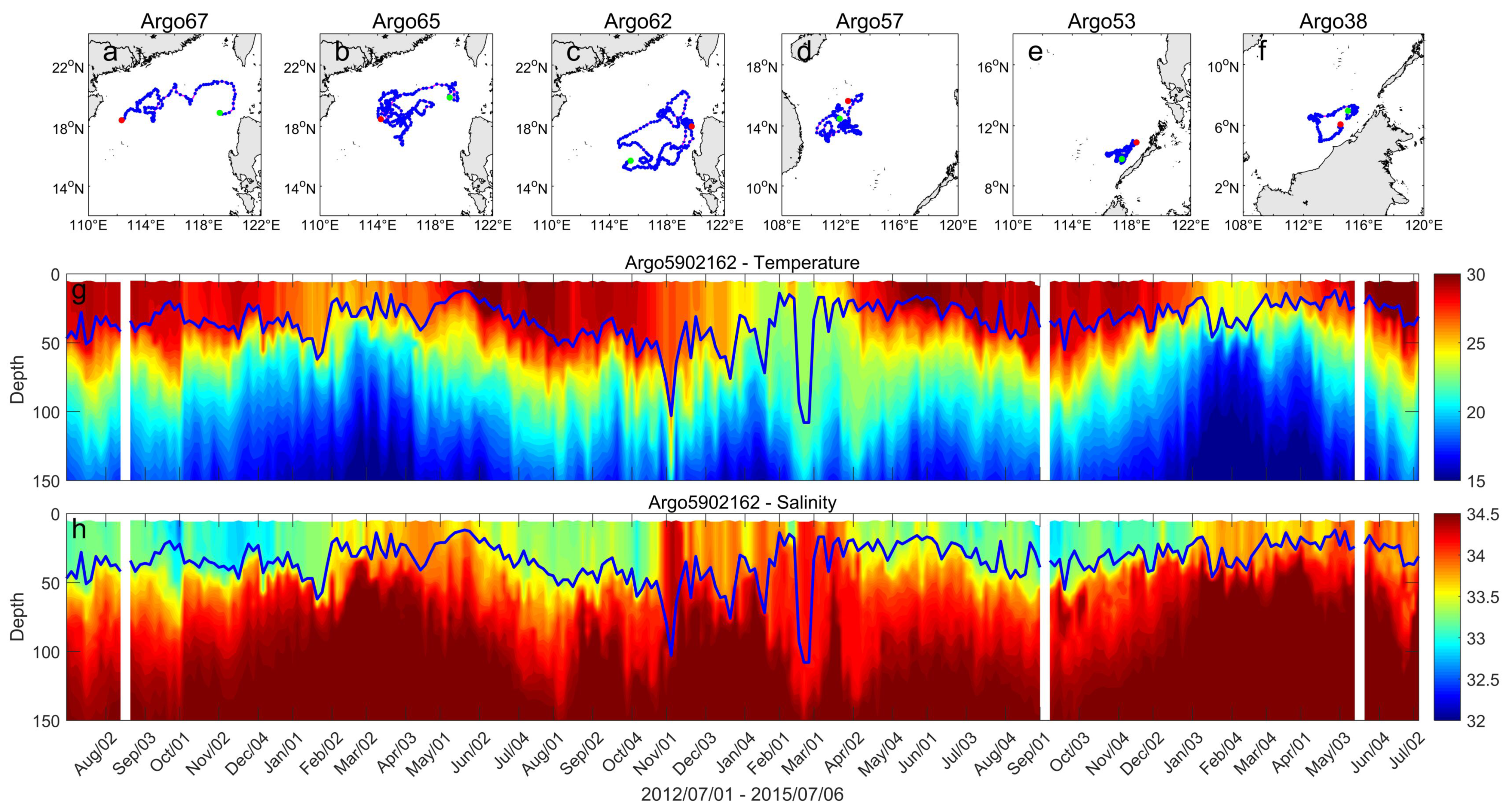

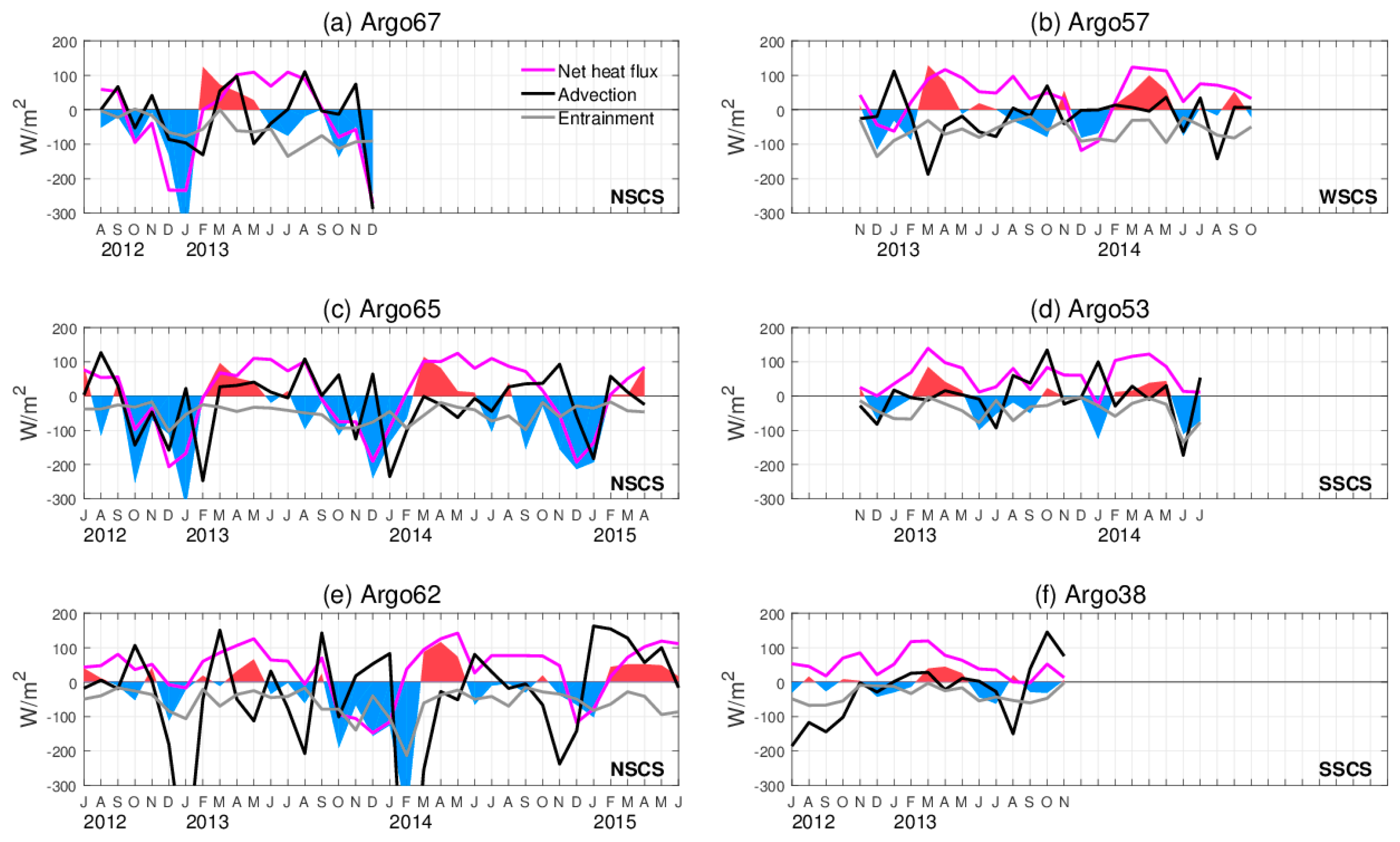

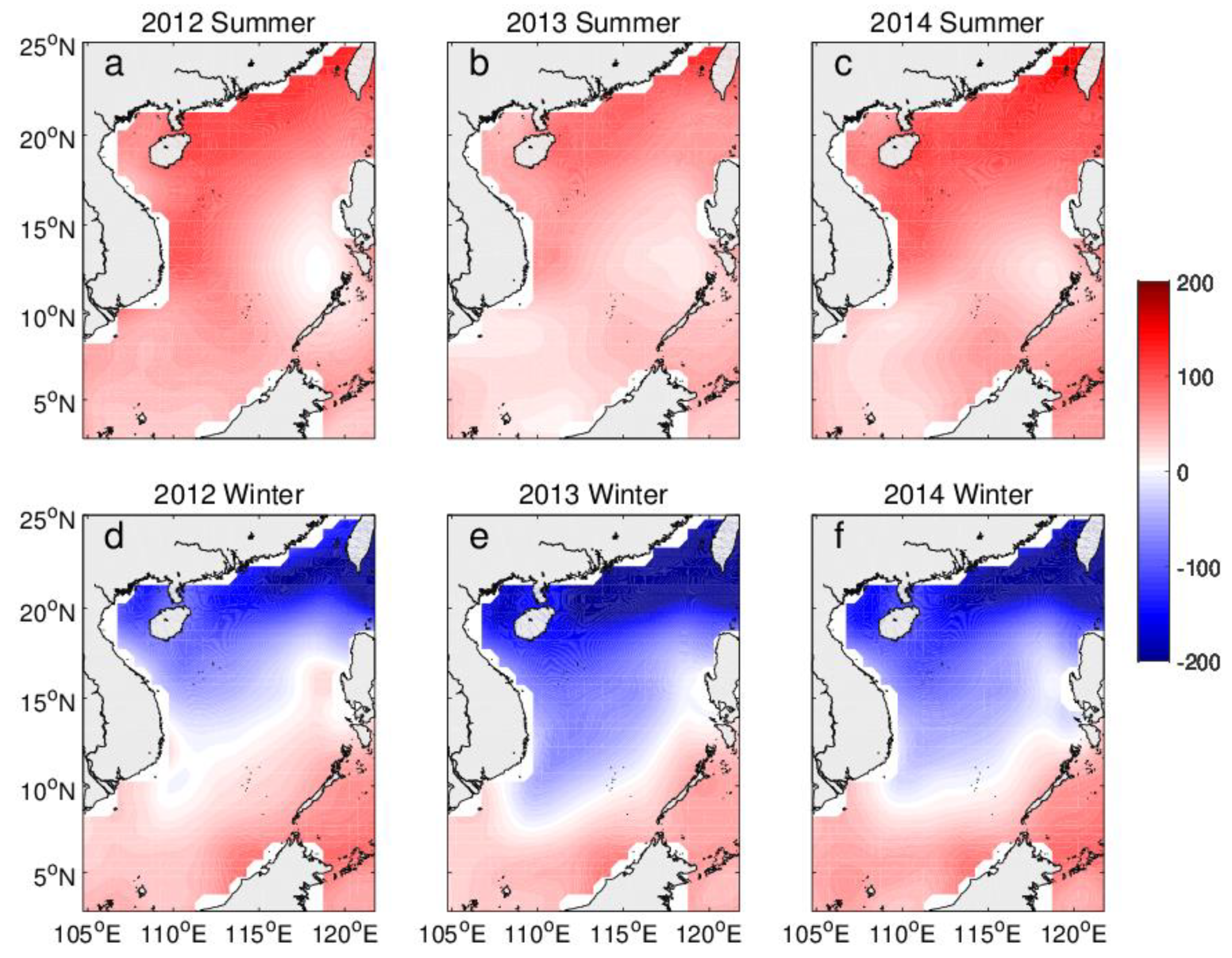
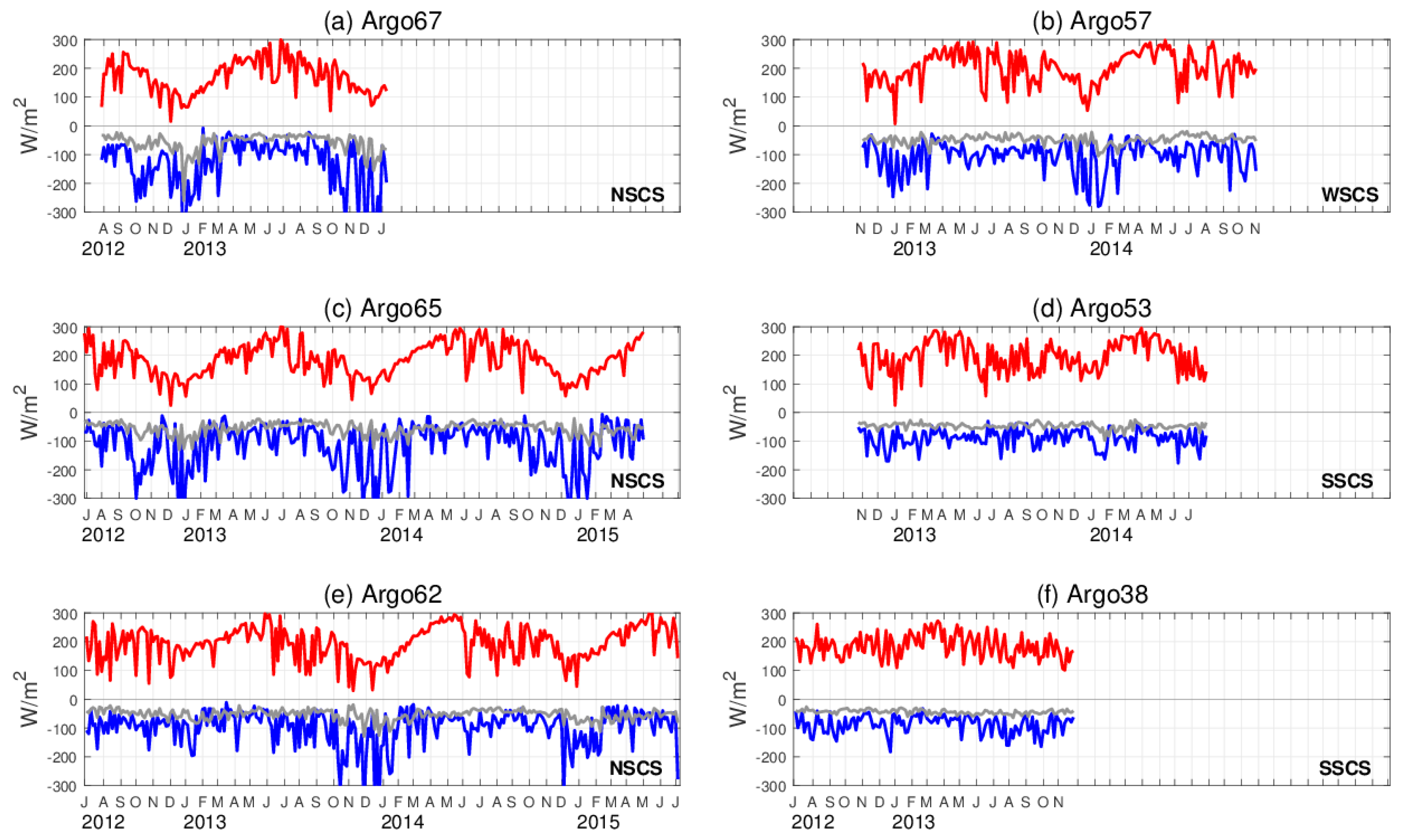

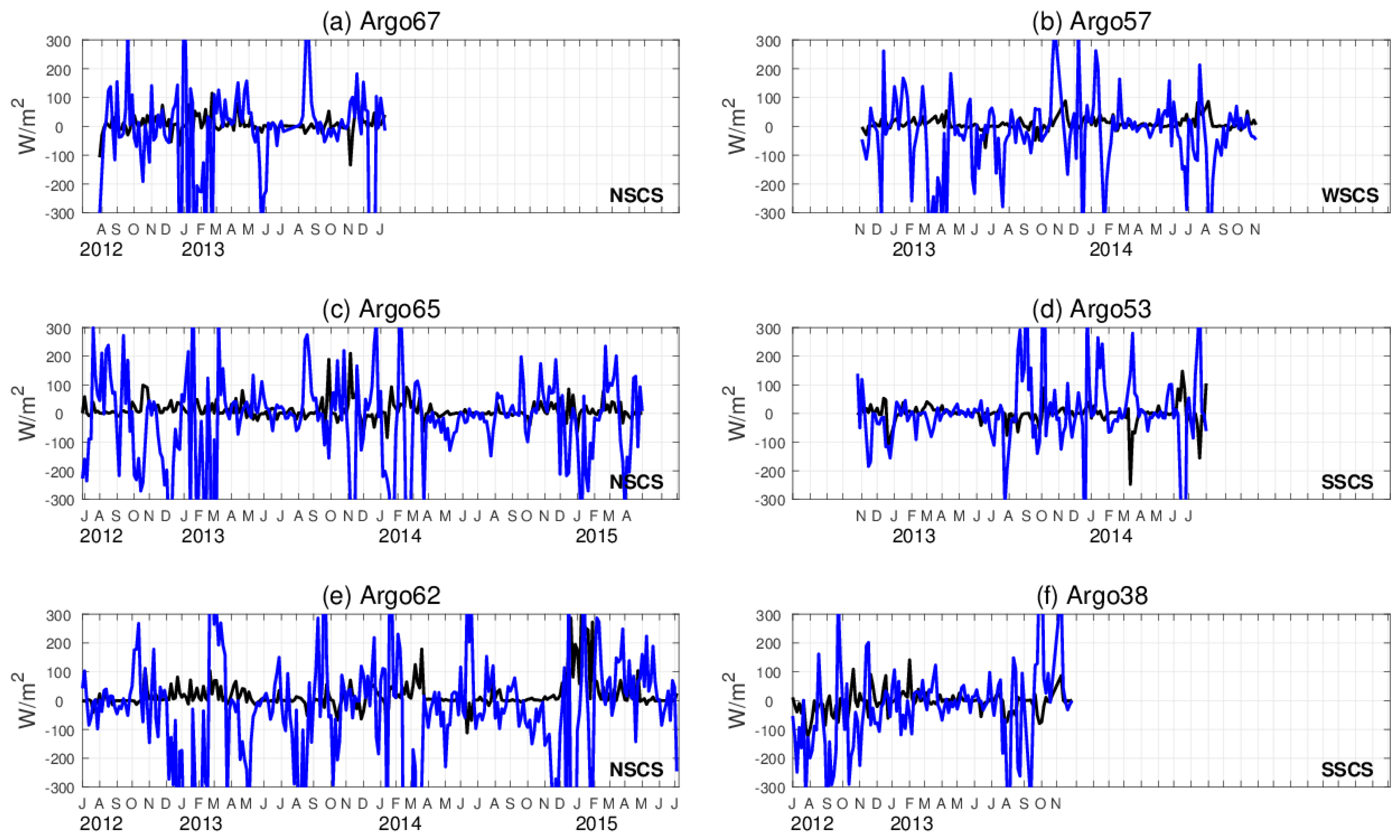

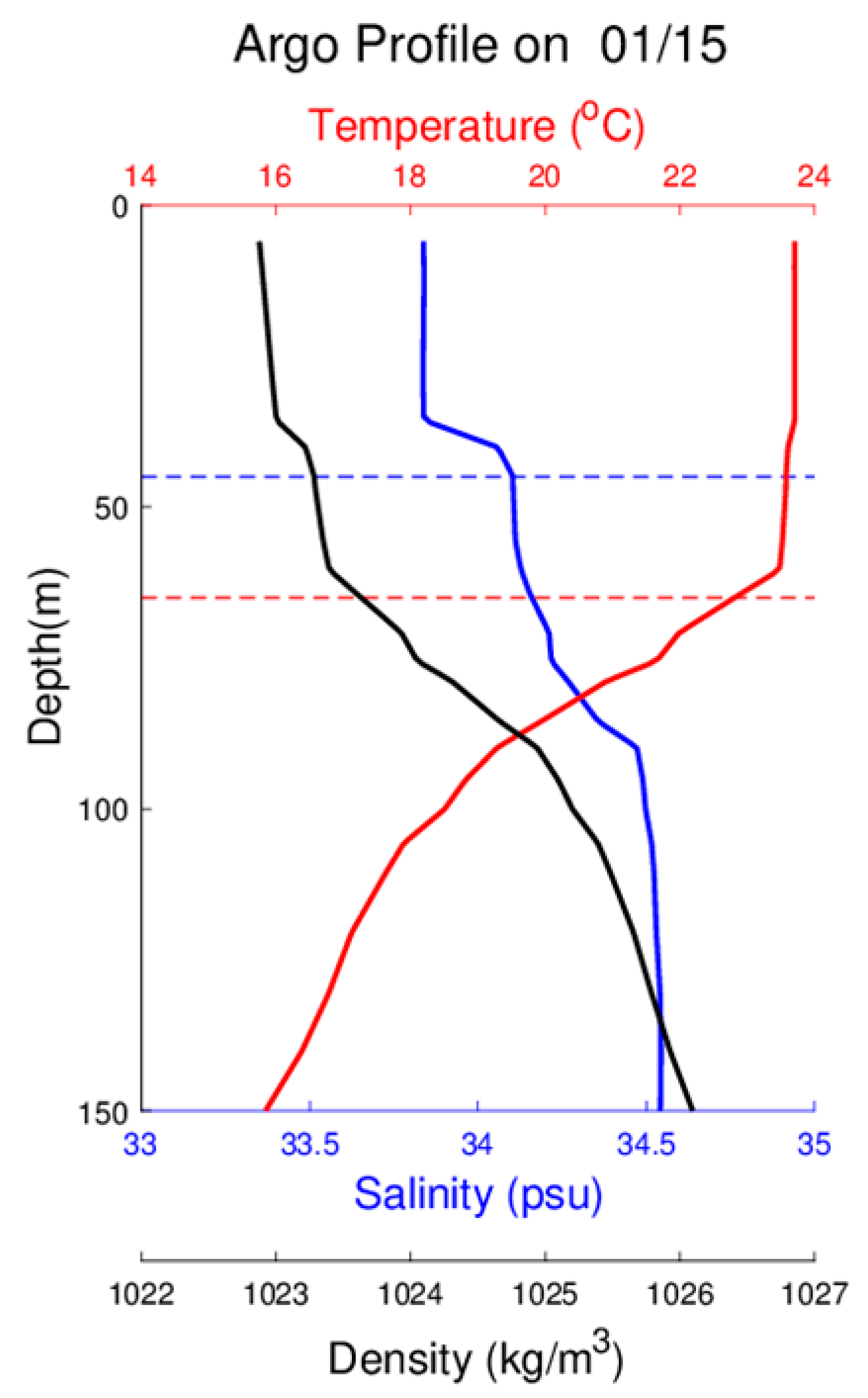
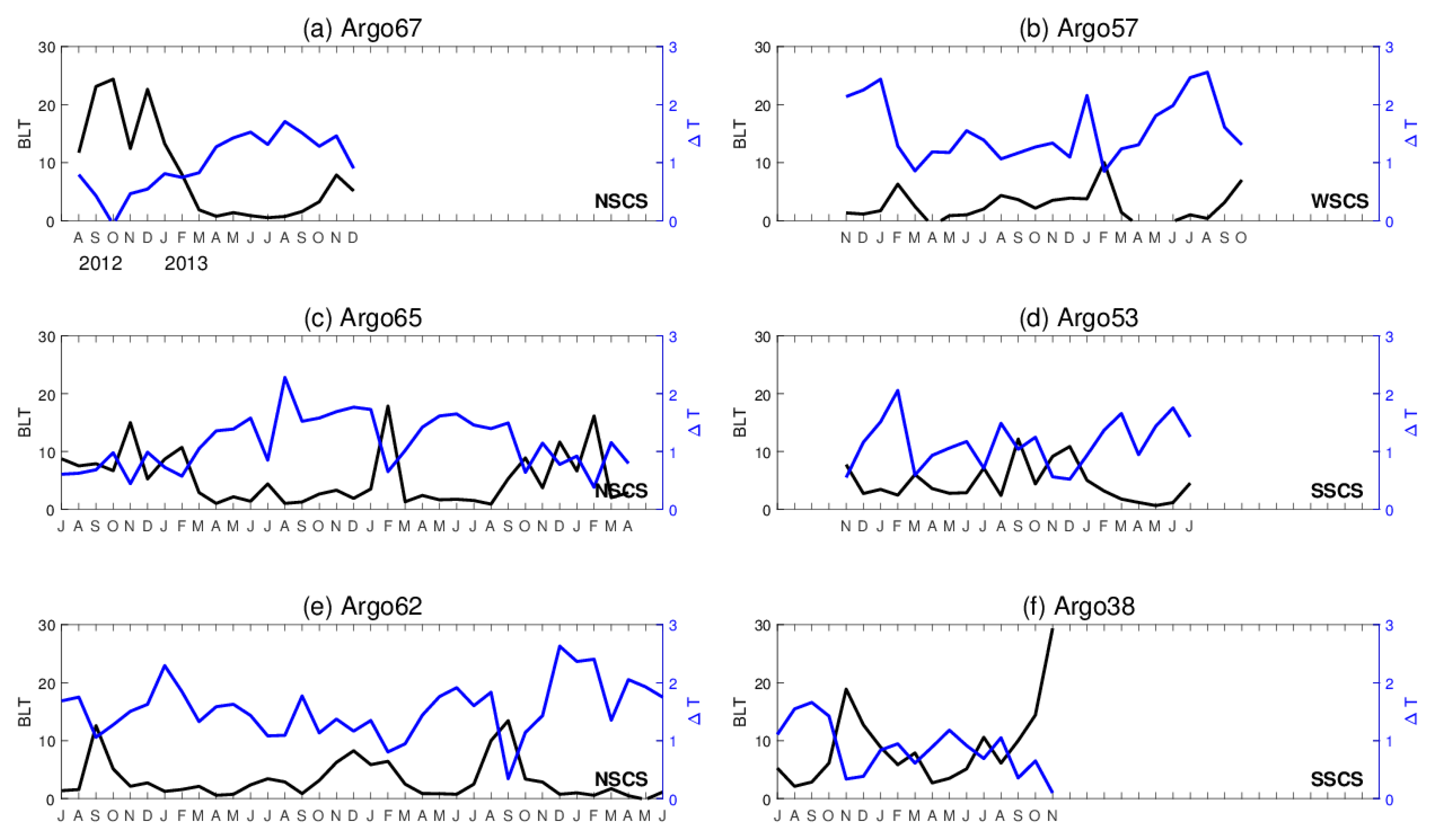


| Argo Floats in the SCS from 2002 to 2016 | |||
|---|---|---|---|
| <1 Year | 1–2 Year | >2 Year | |
| Number of floats | 60 | 35 | 11 |
| Percentage (%) | 56.6 | 33.02 | 10.38 |
| Argo floats used in this study | |||
| Argo | Time period | Coverage area | Sea area |
| 5902167 (Argo67) | 31 July 2012–10 January 2014 | 112–120° E, 18–21° N | NSCS |
| 5902165 (Argo65) | 30 June 2012–2 May 2015 | 114–120° E, 15–20° N | |
| 5902162 (Argo62) | 1 July 2012–6 July 2015 | 114–120° E, 17–21° N | |
| 5903457 (Argo57) | 5 November 2012–3 November 2014 | 110–114° E, 13–16° N | WSCS |
| 5903453 (Argo53) | 27 October 2012–2 August 2014 | 116–118.5° E, 9.5–11° N | SSCS |
| 5904038 (Argo38) | 1 July 2012–9 November 2013 | 112–116° E, 4.5–7.5° N | |
| Year | Season | Argo | dT | Qnet − Qpen | Advection | Entrainment | Residual |
|---|---|---|---|---|---|---|---|
| 2012 | Summer | Argo65 | 5.36 | 61.96 | 53.43 | −33.76 | −76.27 |
| Argo62 | 13.71 | 57.26 | −10.52 | −35.13 | 2.1 | ||
| Argo38 | −13.63 | 38.97 | −148.88 | −60.89 | 157.16 | ||
| Winter | Argo67 | −129.05 | −155.46 | −104.21 | −66.2 | 196.81 | |
| Argo65 | −144.61 | −125.98 | −127.55 | −60.58 | 169.5 | ||
| Argo62 | −38.17 | 11.97 | −260.87 | −70.45 | 281.18 | ||
| Argo57 | −77.82 | −27.62 | 25.11 | −96.14 | 20.83 | ||
| Argo53 | −37.14 | 35.07 | −23.26 | −58.81 | 9.86 | ||
| Argo38 | −28.64 | 63.64 | −0.63 | −18.85 | −72.8 | ||
| 2013 | Summer | Argo67 | −30.78 | 67.83 | 36.06 | −104.81 | −29.86 |
| Argo65 | −33.19 | 54.92 | 34.78 | −48.41 | −74.47 | ||
| Argo62 | −12.85 | 41.87 | −46.66 | −45.67 | 37.62 | ||
| Argo57 | −28.06 | 59.1 | −30.34 | −35.23 | −21.59 | ||
| Argo53 | −40.15 | 42.21 | 1.57 | −38.44 | −45.49 | ||
| Argo38 | −30.78 | 67.83 | 36.06 | −104.81 | −29.86 | ||
| Winter | Argo65 | −146.41 | −90.31 | −90.34 | −71.65 | 105.9 | |
| Argo62 | −224.4 | −75.02 | −225.25 | −119.53 | 195.39 | ||
| Argo57 | −44.4 | −62.26 | 3.97 | −88.77 | 102.67 | ||
| Argo53 | −40.47 | 45.31 | 22.2 | −30.38 | −77.61 | ||
| 2014 | Summer | Argo65 | −73.29 | 89.45 | 6.06 | −76.28 | −92.52 |
| Argo62 | −14.71 | 77.03 | 2.09 | −42.33 | −51.51 | ||
| Argo57 | 14.05 | 68.85 | −33.53 | −66.87 | 45.6 | ||
| Winter | Argo65 | −134.09 | −108.02 | −61.46 | −27.11 | 62.49 | |
| Argo62 | −41.03 | −59.79 | 58.32 | −65.19 | 25.63 |
| Sea Area | Argo | Qnet − Qpen | Advection | Entrainment |
|---|---|---|---|---|
| NSCS | Argo67 | −0.67 | −0.85 | −0.18 |
| Argo65 | −0.42 | −0.84 | −0.16 | |
| Argo62 | −0.21 | −0.93 | −0.53 | |
| WSCS | Argo57 | −0.24 | −0.67 | −0.29 |
| SSCS | Argo53 | −0.23 | −0.94 | −0.48 |
| Argo38 | −0.43 | −0.93 | −0.61 |
© 2019 by the authors. Licensee MDPI, Basel, Switzerland. This article is an open access article distributed under the terms and conditions of the Creative Commons Attribution (CC BY) license (http://creativecommons.org/licenses/by/4.0/).
Share and Cite
Liang, Z.; Xing, T.; Wang, Y.; Zeng, L. Mixed Layer Heat Variations in the South China Sea Observed by Argo Float and Reanalysis Data during 2012–2015. Sustainability 2019, 11, 5429. https://doi.org/10.3390/su11195429
Liang Z, Xing T, Wang Y, Zeng L. Mixed Layer Heat Variations in the South China Sea Observed by Argo Float and Reanalysis Data during 2012–2015. Sustainability. 2019; 11(19):5429. https://doi.org/10.3390/su11195429
Chicago/Turabian StyleLiang, Zhanlin, Tao Xing, Yinxia Wang, and Lili Zeng. 2019. "Mixed Layer Heat Variations in the South China Sea Observed by Argo Float and Reanalysis Data during 2012–2015" Sustainability 11, no. 19: 5429. https://doi.org/10.3390/su11195429
APA StyleLiang, Z., Xing, T., Wang, Y., & Zeng, L. (2019). Mixed Layer Heat Variations in the South China Sea Observed by Argo Float and Reanalysis Data during 2012–2015. Sustainability, 11(19), 5429. https://doi.org/10.3390/su11195429




